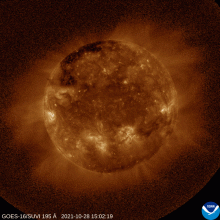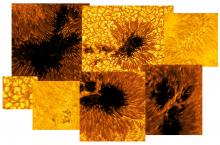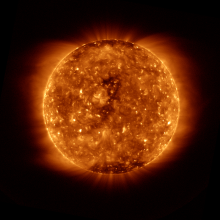Listen to today's episode of StarDate on the web the same day it airs in high-quality streaming audio without any extra ads or announcements. Choose a $8 one-month pass, or listen every day for a year for just $30.
You are here
Seeing Sunspots
The next sunspot cycle will be especially quiet. Unless it’s one of the busiest on record. Two groups have come up with different predictions. It’s as though one has forecast a warm, calm spring afternoon, while the other has predicted a blizzard.
The Sun goes through an 11-year cycle of magnetic activity. At the cycle’s peak, the Sun is covered with more sunspots. These giant storms are cooler than the surrounding gas, so they look dark by comparison. At the end of each cycle, the Sun’s magnetic field flips over, starting the new cycle.
The number of sunspots varies from cycle to cycle. The most recent one, which ended last year, was unusually quiet. That’s good news for Earth’s technology. Solar storms can disrupt satellites, knock out power grids, and cause other problems.
NASA and NOAA have predicted that the new cycle will be just as tranquil as the last. But a team of American and British researchers disagrees. It predicts twice as many sunspots at the cycle’s peak. That would make it one of the strongest cycles ever seen.
The team used a method of measuring the length of a sunspot cycle that’s different from the one that’s most commonly used. According to that method, the last cycle was shorter than average — just shy of 10 years. The team’s models say that short, quiet cycles usually are followed by busy cycles. So it predicts peak rates of more than 200 sunspots at a time — a busy season for the Sun.
Script by Damond Benningfield





